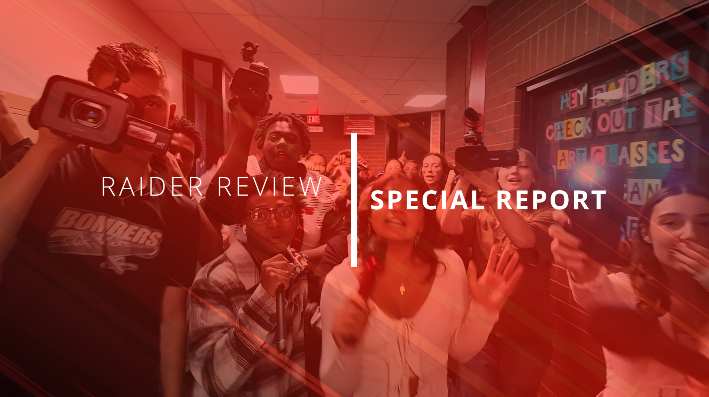Throughout the halls, students buzz about the difficult and unforeseen style of the new PARCC exam, as compared to the state’s previous standardized test, TCAP. The opposition from students that met the newly instated test in the form of opt-out movements, protests at the State Capitol, and an organized lack of effort draw attention to the disadvantages of the standardized testing system in Colorado and even the nation.

On March 7th, students flocked to the State Capitol, protesting the test on the grounds that it did not assess the curriculum that was taught in the classroom and calling for state-owned rather than private company-owned testing. The implications of this fact and this fact itself are something many students are not aware of; while students have formed opinions of the testing questions and schedule, the background of the test and the policies behind its adoption are not common knowledge.
What is the PARCC exam really?
The PARCC exam, or the Partnership for Assessment of Readiness for College and Careers, is a test that has recently been embraced by several states, but while its name is recognized by Colorado students, the reason behind its acceptance is not. Common Core, a set of state standards that has been taken up by 45 states as well as the District of Columbia, was adopted by Colorado in 2010, leading to the replacement of TCAP with the PARCC exam, which aligns itself more heavily with the new standards.
While Common Core and the PARCC exam focus on increasing the rigor of Colorado public education, Common Core’s critics view the transition of standards as an abrupt and difficult one. The test assesses reasoning as opposed to memorization, but the leap from familiar TCAP questions to AP U.S History style prompts has left students reeling and stressed out, while others simply did not take it.

Junior Chris Garrity who did not attend the testing day said, “I just didn’t feel like it was important…we were just the guinea pigs. I felt like they had enough of those already.”
The PARCC exam does what it promises, providing students with questions that better assess new state standards, but this promise is itself the downfall of the changes in state testing: the state dictates the academic standards, but the curriculum a school teaches is a local decision. That means that there is a disconnect between the test and what students are learning—the test material may not be covered in class.
Common Core, PARCC, and Race to the Top, oh my!
The federal Race to the Top program funds schools through competitive grants based in part on standardized test scores. Under Race to the Top, enacted in 2009, yearly testing is required in order to assist in the evaluation of teachers, which is then used to decide which states are given the grants.
Essentially, states with better test scores, teacher performance, and overall success factor are awarded money.
Opponents of Common Core argue that it is a federal incentive in that states that incorporate the system are looked upon more favorably in the Race to the Top competition. In the same way that CSAP was adopted as a result of the federal No Child Left Behind policy (enacted in 2001), many argue that PARCC has been adopted in order to gain more funding from Race to the Top.
The Money Trail
Supporters of Race to the Top and Common Core see the recently established standards and the reliance on test scores that have been developed by No Child Left Behind and continued with Race to the Top as positive and believe that the PARCC exam is a step in the right direction, but what students often don’t know is where funding comes from and where it is being spent.
After three failed attempts at the Race to the Top competition, Colorado has been one of seven states to win in this round of the contest this year, winning $17.9 million. Colorado applied for $175 million and spent $60,000 on the application for the competition.
So great, that’s $17.9 million more for Colorado students, but millions of dollars that could be spent on books, additional classes or after school programs are used for standardized testing. According to the Denver Post, the cost to the state for the spring round of PARCC testing was $36.8 million, of which only $7.7 million was covered by federal funding. The additional cost of the district actually giving the test is $8.1 million, and that’s not including the cost of paying staff.

Because the test is owned by a private company rather than the state, each state that participates in the PARCC exam will give Pearson (the corporation that owns PARCC) $26.8 million of the total costs.
“It’s just another means to funnel money away from the classroom and my students,” said science teacher Tom Brown, “that goes into a corporation like PARCC or something else.”
If the name Pearson looks familiar, it’s because the corporation also owns a publishing company that publishes textbooks. The British-owned company rakes in billions of dollars a year from schools.
The two main Common Core tests, PARCC and the Smarter Balanced Assessment, have received $360 million from Race to the Top in order to develop the exams, an estimated $305 million of which goes directly to the vendors like Pearson.
This is the reason for which senior Daniel Parache disagrees with much of standardized testing.
“I don’t like any third-party testing because most of the money goes to the company and not to the schools,” said Parache.
Effect on Teaching and Funding
Besides the fact that large corporations receive money at the expense of the education budget, the indirect effect on teachers and school curriculum may also be harmful to students. Students have been told since the inception of CSAP that testing is important because high scores often raise the property value of houses, bringing in more money, and while test scores do not directly affect a school’s budget, according to Global Post, a school that “falls below adequate testing progression” may be subject to losing money in the form of “grants and other forms of funding.” This policy puts low-scoring schools at risk for low funding, and without funding, performance can decline rather than improve due to a lack of resources.
Additionally, because PARCC scores are linked to teacher evaluation in Race to the Top in several states including Colorado, the test may become a driving force for teaching to the test or molding curriculum in order to yield adequate test results from students.
“Much of what we try to do is no longer simply about learning content,” said Brown. “It’s about trying to teach what’s on the test.”
Students have already felt the effects of curriculum based upon testing material in AP classes.
“For the AP tests,” said Parache, “a lot of the times, we skip over the kid’s learning…in order to fit every single little detail in before the test.”

According to the Denver Post, starting this 2014-2015 school year, “teachers lose non-probationary status if they score ineffective for two consecutive years,” meaning a teacher may be fired in Colorado if their students’ PARCC test scores are too low for two years straight.
To make matters worse, teachers or administration that yield superior test scores may be given monetary rewards by the state; the Houston Board of Education awarded $3,000 to teachers with benchmark performance and $25,000 to administrators of schools that met the state performance guidelines.
Federal funding can also be withheld if there is less than a 95% attendance rate for the PARCC exam across a state. Though the official numbers of attendance have not been released, Rangeview itself has had a low attendance rate due to the number of students who decided to opt out of the test.
Brown, who substituted as a proctor for the PARCC exam commented on the attendance of the classroom he proctored for one morning, “The attendance was poor; I think we had nearly half of the students gone.”
Standardized testing and Students
Common Core and Race to the Top seek to improve the quality of public education in America, but students and teachers alike worry that standardized testing is actually doing the opposite.
Tests have a tendency to create a one-size-fits-all regiment, providing students with a single method to prove what they know when it counts.
“One of the main reasons I don’t like it is that people are different,” said senior Abby Schouten. “They see things differently; they learn things different ways, so standardized tests, they can’t accommodate everyone’s creativity, so it’s not helping the student. They’re only helping the schools and teachers. The only benefit I see out of it is just the money.”
Junior Michael Millan feels that reliance on testing has become too heavy, saying, “I don’t think a test should define your intelligence.”
With weekly, state, and national tests, students feel that it is easy to get buried under the stress and anxiety that comes with assessments.
“Tests just make me so stressed out,” said Schouten. “I can’t focus on anything else. I have trouble sleeping the night before.”

Some students even result to prescription or drugstore medication in order to cope with the anxiety that accompanies tests such as PARCC, ACT, or SAT.
“I have test anxiety,” said Schouten, “so [during] any kind of test….I instantly start freaking out, even though I know the material…So I have to take calming pills to relax me. It’s awful.”
Standardized testing has increased the influence of privatized corporations on education, enabling curriculum to be manipulated in order to teach to tests like PARCC or AP exams rather than teaching general concepts or real-world skills that may not benefit a student on a test. Though PARCC and Common core have been instated with education in mind, the main beneficiary has been testing companies, not students.




